A Technical workshop on Agroecology for the Khasi, Jaintia and Garo Hills cluster took place on the 16th and 17th of September, 2021 via a virtual video meeting. The resource persons, Thomas Iangjuh (Junior Scientist, Bio Resource Development Centre, Shillong, Meghalaya) and Reccica Lyngkhoi (Microbiologist, Bio Resource Development Centre, Shillong, Meghalaya) helped facilitate this event and made it a success.

NESFAS staff & Indigenous communities of Meghalaya attending virtual technical workshop on Agroecology with local farmers.
The key objectives of this workshop were:
- To promote, conserve and enhance agroecology within the communities.
- Sharing of knowledge between members of the Agroecology Learning Circle (ALC) and participating members of the communities.
- To promote and facilitate co-creation and cross learning between participating members.
- Addressing key issues and the solutions to the same.
- Eventual scaling up of agroecological practices for sustainable food production.
NESFAS’ Executive Director, Pius Ranee addressed the attendees and brought everyone up-to-speed regarding the aims of the workshop as well as the eventual goal that everyone must strive for. This included, dissemination of the documentation to the farmers for complete transparency in the system; revival of documentation of traditional methods of farming and addressing of the issues in the farming and food system.
The indigenous farmers were asked to identify and address the issues regarding their farming practices prior to the workshop. Bah Thomas did so with the help of a presentation, which also addressed some solutions to the problems at hand with the help of integration of modern science. The presentation was an eye-opener for the attendees as it discussed management of several issues and factors, which might otherwise be overlooked. These included:
- Management of soil erosion and run-offs by farming methods like Mulch farming and Contour farming.
- Soil Fertility Management by use of bio-fertilizers, crop rotation with legumes and improvement of germplasm and organic seeds.
- Crop Health and Integrated Pest Management and diseases in different crops.
- Integrated Pest Management systems
- Reasons behind non-fruiting of crops

A presentation on Soil Fertility by Thomas Iangjuh (Junior Scientist, Bio Resource Development Centre, Shillong, Meghalaya)
The presentation also contained a section which discussed the Management and Preservation of Traditional Seed, including:
- Practices and methods to increase seed viability such as control of seed moisture content, control of temperature, refrigeration, etc..
- Good practices for prolonged seed viability such as temperature control and exposure to light.
- Practices to ensure seed saving in unpredictable weather.
Several pertinent questions were raised by the farmers during the workshop were also quickly cleared out. They were as follows:
- How does one identify if a seed has been given chemicals (medicine) or not, if we buy from the markets?
To check the color of the seeds and see if they appear to be the original color or not. A different color implies it has been given chemicals (inorganic). It’s recommended to always ask the seller.
- How do we initiate seeds exchange?
It is recommended to test the seed if it is suitable for the particular area or not. To introduce the seed in the new region, check and monitor the plant if it is equal (basic criteria) to what it is being exchanged for. After 3 seasons it is acclimated to the regions. First three seasons have to be monitored.
- Why have Citrus fruits dropped in the Garo hills?
It is happening everywhere in and around Meghalaya. The main reason is that they are not well maintained; using measures like prevention by strengthening the plant, providing nutrition to the plant for resistance to diseases, use of traps, installing traps- light, yellow traps etc. can be done to prevent the same.
- Where do we go for soil testing?
There is an availability of soil testing kits. NESFAS plans to visit communities soon to conduct testing of the same.
Besides this, a decision was also made to conduct training on the process of making compost with dry hay and waste. Overall, the training session saw a lot of buzz and created a platform for indigenous farmers and experts to share their views on preserving traditional farming techniques and also documenting them for continual use for the future.
 Translate
Translate




